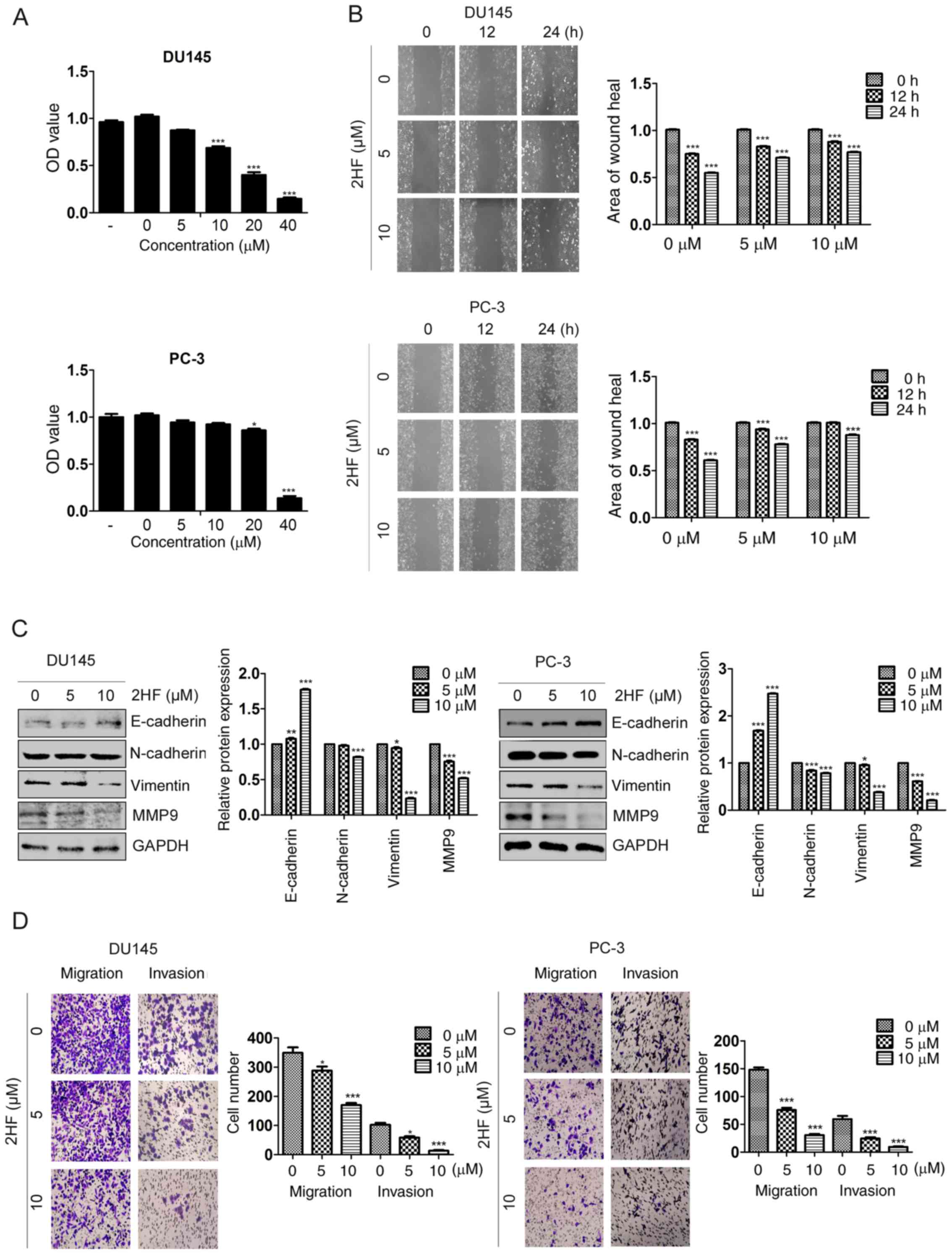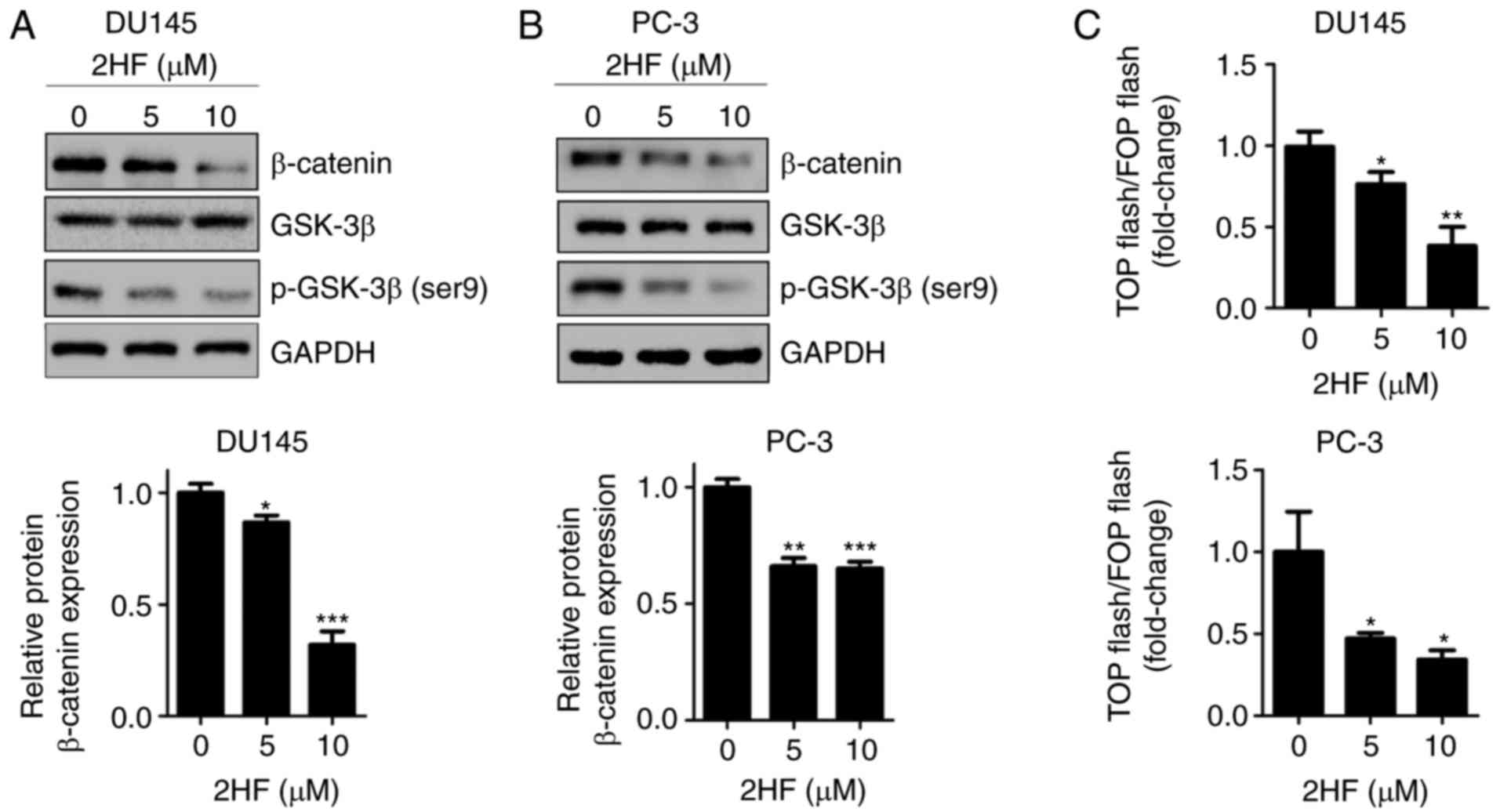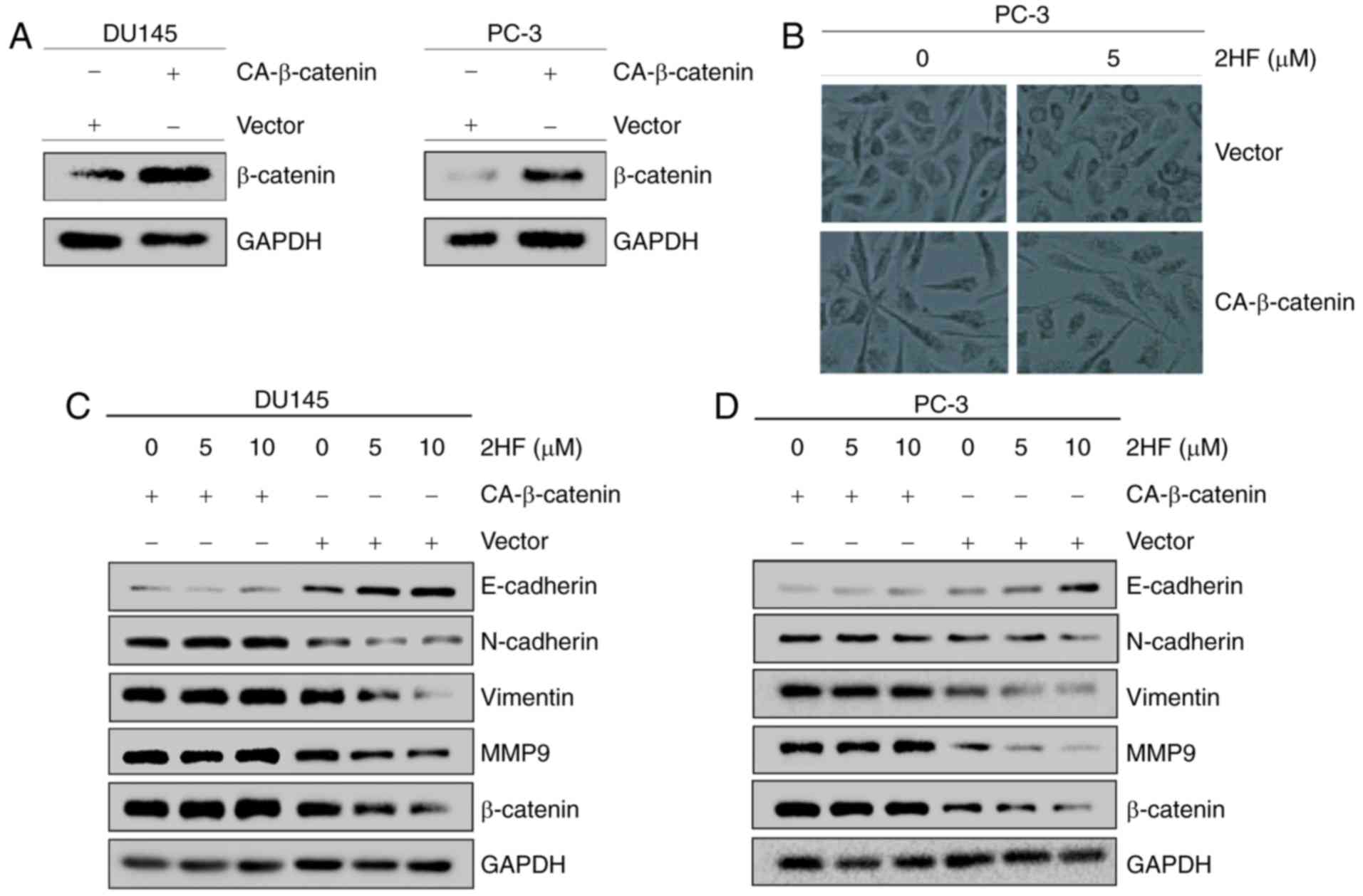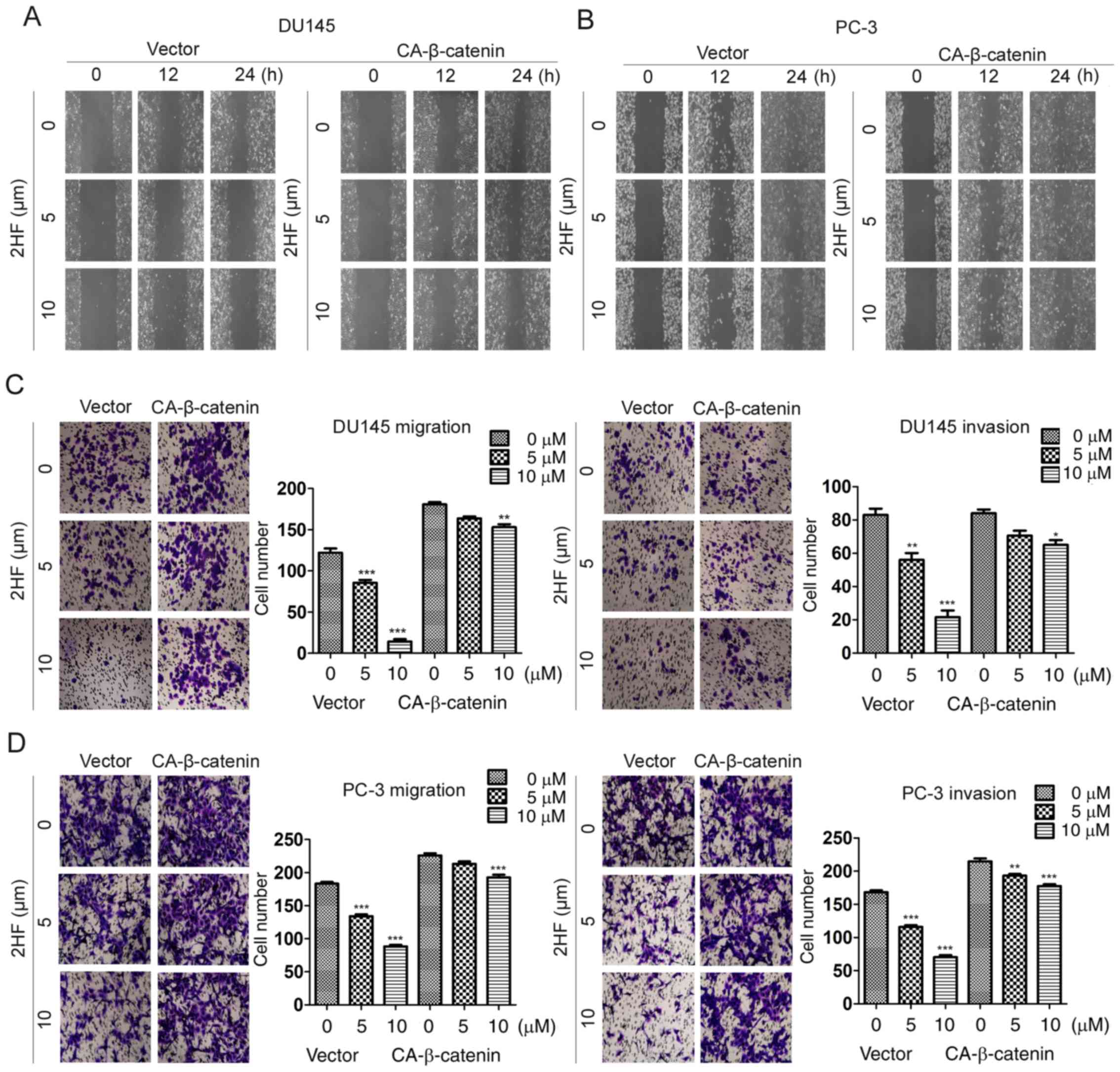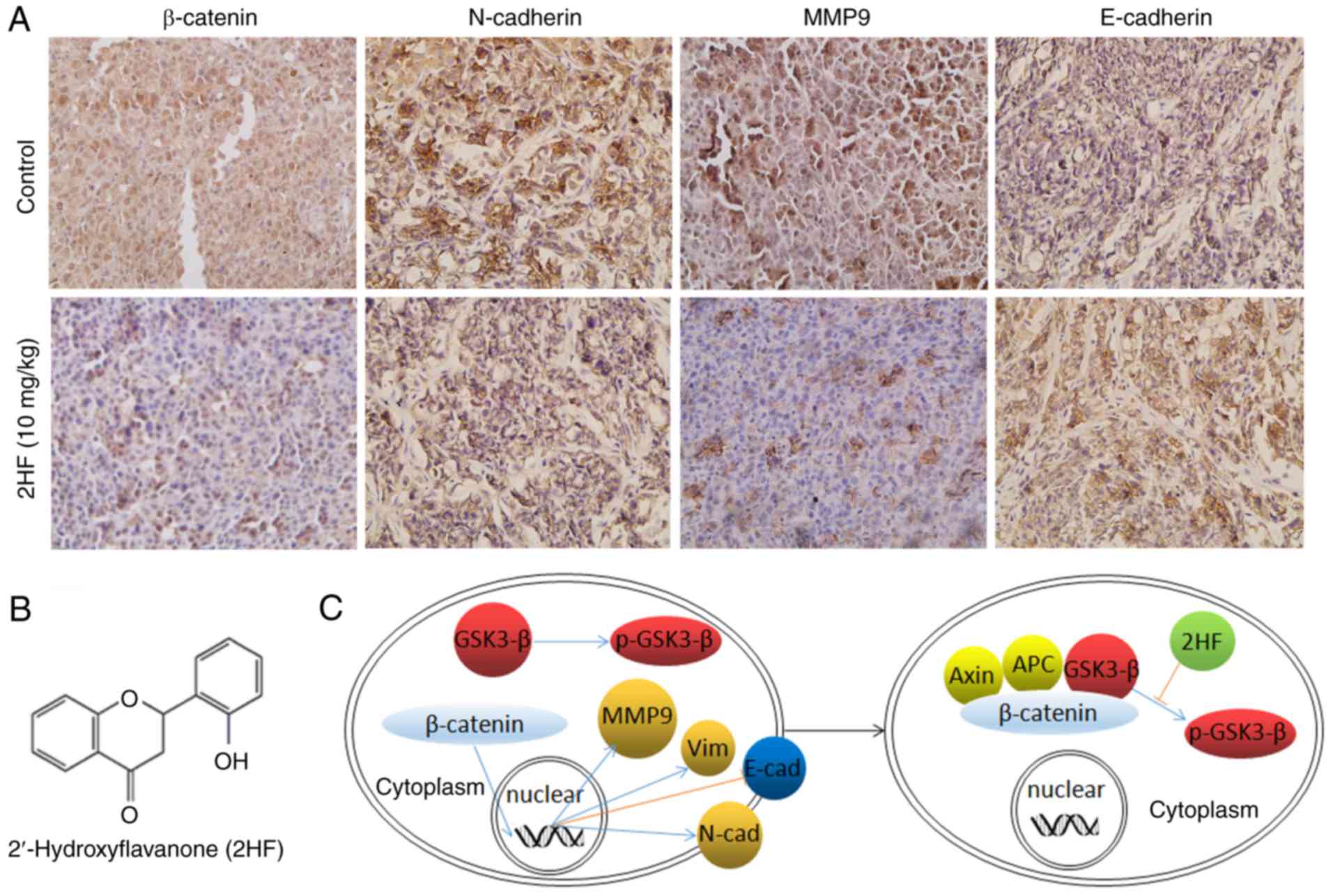2'‑Hydroxyflavanone inhibits epithelial‑mesenchymal transition, and cell migration and invasion via suppression of the Wnt/β‑catenin signaling pathway in prostate cancer
- Authors:
- Published online on: August 31, 2018 https://doi.org/10.3892/or.2018.6678
- Pages: 2836-2843
Abstract
Introduction
Prostate cancer (PCa) is one of the most common types of epithelial malignant tumor and its morbidity is the second highest among males in USA (1). Traditional treatment for metastatic PCa is androgen deprivation therapy (ADT); however, the majority of patients will develop castration-resistant PCa (CRPC) within 12–18 months (2). At present, few therapeutic strategies, including docetaxel-based chemotherapy and new generation anti-androgen therapy, are available for prolonging patient survival. Therefore, it is necessary to identify novel drugs to prevent or treat metastatic PCa.
Epithelial-mesenchymal transition (EMT) serves an important role in cancer metastasis, which makes the cells more motile and invasive (3,4). Additionally, metastasis is the main cause of mortality in patients with PCa. The key characteristic of EMT is the downregulation of epithelial markers and the upregulation of mesenchymal markers (5). Several signaling pathways, including the TGF-β, Wnt and Notch pathways, have been revealed to be associated with these transitions (6–8). Therefore, these pathways may be potential targets in the treatment and prevention of metastatic prostate cancer.
Recently, numerous plant metabolites have exhibited bioactivity (9–11), in which flavonoids have functions, including anti-oxidative (12), anti-angiocardiopathy (13), anti-inflammatory (14) and antitumor activities (15,16). Flavonoids are able to inhibit cell proliferation, promote cell apoptosis and autophagy (17), and reverse drug resistance. 2′-Ηydroxyflavanone (2HF), an abundant natural flavonoid from plants, has antitumor activity in different types of cancer, including renal (18), lung (19) and colon cancer (20), and osteosarcoma (21). Our previous study has also demonstrated that 2HF could inhibit proliferation and induce apoptosis through blocking the Akt/STAT3 signaling pathway in PCa (17); however, the role of 2HF on EMT, and cell migration and invasion remains unknown.
In the present study, 2HF, which has a lower cytotoxicity in cells, was used to treat metastatic PCa cells to investigate its effects on EMT, and cell migration and invasion. The results clearly demonstrated that 2HF could suppress EMT, and cell migration and invasion in a dose- and time-dependent manner in DU145 and PC-3 cell lines and a subcutaneous xenograft, in which 2HF could inhibit the activation of the Wnt/β-catenin signaling pathway.
Materials and methods
Cell culture and treatment
PCa PC-3 and DU145 cell lines were purchased from the American Type Culture Collection (Manassas, VA, USA) and cultured in Dulbecco's modified Eagle's medium (DMEM; Gibco; Thermo Fisher Scientific, Inc., Waltham, MA, USA), supplemented with 10% fetal bovine serum (FBS; Gibco; Thermo Fisher Scientific, Inc.) at 37°C with 5% CO2. 2HF powder was obtained from Sigma-Aldrich; Merck KGaA (Darmstadt, Germany) and dissolved in dimethyl sulfoxide (DMSO). Cells were treated with 0, 5 or 10 µM 2HF in 1% FBS for 24 or 48 h at 37°C.
Plasmids and cell transfection
A constitutively active β-catenin (CA-β-catenin; S37A) plasmid, at a concentration of 1 µg/ml, and its control vector were obtained from Dr Zijie Sun (Stanford University) and described in our previous study (22). For cell transfection, 3×105 cells were seeded into a 6-well plate the day before transfection. Transfection was performed using X-tremeGENE HP DNA Transfection Reagent (Roche Diagnostics, Basel, Switzerland), according to the manufacturer's protocol. The cells were used in subsequent experiments following transfection for 48 h.
MTT assay
A total of 2×103 cells in 200 µl complete DMEM were seeded into each well of a 96-well plate. Different concentrations of 2HF (0, 5, 10, 20 or 40 µM) were added into each well on the second day. A total of 48 h later, 20 µl MTT (Sigma-Aldrich; Merck KGaA) was added into cells and the cells were incubated for another 4 h at 37°C with 5% CO2. Subsequently, medium was removed and 150 µl DMSO was added into the wells to dissolve the purple formazan. Following agitating for 10 min, the optical density value at 490 nm was measured by a microplate autoreader (Bio-Tek Instruments, Inc., Winooski, VT, USA). Independent experiments were repeated three times and all the procedures were performed according to the manufacturer's protocol.
Wound healing assay
2HF was added when the cells in the 6-well plate reached 100% confluence. A total of 24 h later, artificial wounds were made using a 200-µl pipette tip. Wounds were monitored by an inverted microscope (magnification, ×200) after 12 and 24 h.
Transwell migration and invasion assay
DU145 and PC-3 cells were harvested following 2HF treatment for 24 h. For the migration assay, 3×104 cells in 200 µl serum-free DMEM were seeded into the upper chamber (8-µM pore polycarbonate membrane filters) of Transwell inserts without Matrigel. For the invasion assay, 6×104 cells in 200 µl serum-free medium were seeded into the upper chamber of Transwell inserts coated with Matrigel (Sigma-Aldrich; Merck KGaA). The lower chamber was filled with 800 µl medium containing 20% FBS. Following incubation for 24 h, the Transwell inserts were fixed with 4% paraformaldehyde for 15 min at room temperature and stained with 0.1% crystal violet for 15 min at room temperature. Next, the number of cells was counted in three random fields using an inverted light microscope (magnification, ×200).
Western blot analyses
Following treatment with 2HF for 48 h, cells were washed with cold PBS 3 times. Next, the radioimmunoprecipitation assay buffer (50 mM Tris, pH 8.0, 150 mM NaCl, 0.1% SDS, 1% NP40 and 0.5% sodium deoxycholate) containing proteinase inhibitors (1% inhibitors cocktail and 1 mM PMSF; Sigma-Aldrich; Merck KGaA) was used to prepare cell lysates. Protein determination was performed using abicinchoninic protein assay kit (Thermo Fisher Scientific, Inc.). Subsequently, 10–20 µg proteins were separated on 10–12% SDS-PAGE and transferred to nitrocellulose membranes. Following blocking of the membrane in Tris-buffered saline with 0.1% Tween-20 and 5% skimmed milk for 1 hat room temperature, the membrane was incubated with the following specific primary antibodies diluted in 5%BSA (dilution 1:1,000): Mouse β-catenin (cat. no. 610153; BD Biosciences, Franklin Lakes, NJ, USA), mouse glycogen synthase kinase-3β (GSK-3β; cat. no. sc-71186; Santa Cruz Biotechnology, Inc., Dallas, TX, USA), rabbit phosphorylase-glycogen synthase kinase-3β (p-GSK-3β; ser9; cat. no. 5558; Cell Signaling Technology, Inc.), rabbit Vimentin (cat. no. 5741; Cell Signaling Technology, Inc.), rabbit E-cadherin (cat. no. sc-21791; Santa Cruz Biotechnology, Inc.), rabbit N-cadherin (cat. no. sc-59987; Santa Cruz Biotechnology, Inc.), rabbit matrix metalloproteinase 9 (MMP9; cat. no. sc-21733; Santa Cruz Biotechnology, Inc.) and GAPDH (mouse; cat. no. KC-5G4; Kangchen BioTech Co., Ltd., Shanghai, China) overnight at 4°C. Following washing with TBST, membranes were incubated with horseradish peroxidase-conjugated secondary antibodies: Goat anti-mouse IgG (cat. no. P/N 925-32210; LI-COR Biosciences, Lincoln, NE, USA), goat anti-rabbit IgG (cat. no. P/N 925-32211; LI-COR Biosciences) for 1 h at room temperature. The secondary antibodies were diluted in TBST (1:5,000). Following washing with TBST, the membranes were visualized by an enhanced chemiluminescence detection system (version 3.0; Bio-Rad Laboratories, Inc., Hercules, CA, USA). GAPDH was used as an internal control. All the densitometric analysis was performed using ImageJ software (version 1.48; National Institutes of Health, Bethesda, MD, USA).
Dual-luciferase reporter assay
For the reporter gene assay, 5×104 cells seeded into 24-well plates were transfected with 200 ng β-catenin Firefly luciferase reporter gene constructs (TOP or FOP) and 1 ng of the pRL-SV40 Renilla luciferase construct (as an internal control) using X-tremeGENE HP DNA Transfection Reagent (Roche Diagnostics, Basel, Switzerland) for 24 h, prior to being subjected to 2HF treatment. Cell extracts were prepared 48 h after treatment, and the luciferase activity was measured using the Dual-Luciferase Reporter assay system (Promega Corporation, Madison, WI, USA) according to the manufacturer's protocol. β-catenin transcriptional activity was measured by the ratio of TOP and FOP luciferase activity. Relative luciferase activity is represented as the mean ± standard error of the mean of each sample after normalizing to the control.
Immunohistochemical (IHC) staining and evaluation
Xenograft tumor tissues and sections were collected as described in our previous study (17). Xenograft tumor tissues were obtained from the BALB/c-nu mice in our previous study. A total of 16 male BALB/c-nu mice aged 3–4 weeks and weighing 15–20 g were purchased from the Shanghai Laboratory Animal Center (SLAC, Shanghai, China). The mice were housed at room temperature in a sterile room and fed ad libitum with high pressure sterilized food and water without any light/dark cycle (17). Xenografts were harvested for staining, and IHC was performed using a Dako Autostainer Plus system (Dako; Agilent Technologies, Inc., Santa Clara, CA, USA) as previously described (17), in which the fixative was processed at room temperature (20–25°C) in 4% paraformaldehyde. The thickness of each slide was 5 µm. Following deparaffinization, washing in xylene, rehydration in a descending alcohol series, antigen retrieval for 5 min in a pressure cooker at 120°C, and 10-min endogenous enzyme activity blocking in 3% hydrogen peroxide-methanol at room temperature. Following blocking of the slides in 5% BSA for 30 min at room temperature, slides were incubated with specific primary antibodies as described earlier at 4°C overnight. Following washing with PBS 3 times, slides were incubated with a secondary antibody as described earlier for 30 min at room temperature. Substrate hydrogen peroxide was used to detect the signal and hematoxylin was used for counterstaining at room temperature for 30 sec. Next, the slides were mounted in resin. Images were captured using an inverted microscope (magnification, ×200).
Statistical analysis
All assays were repeated in triplicate in three independent experiments, and quantitative data are presented as the mean ± standard error of the mean. The statistical analyses were conducted using one-way analysis of variance followed by Bonferroni's adjustment for multiple comparisons. P<0.05 was considered to indicate a statistically significant difference. All statistical analyses were performed using SPSS 15.0 (SPSS Inc., Chicago, IL, USA).
Results
2HF inhibits EMT, and the cell migration and invasion of PCa cells
Our previous study reported that higher concentrations (20 and 40 µM) of 2HF could inhibit proliferation and induce apoptosis of PCa cells (17), but the effects of lower concentrations of 2HF on EMT, and cell migration and invasion in PCa remains unknown. The present study used 5 and 10 µM 2HF with a lower cytotoxicity to treat two metastatic PCa cell lines, DU145 and PC-3, respectively (Fig. 1A). The results of the present study demonstrated that 2HF could decrease the wound healing rate in a dose-dependent manner in DU145 and PC-3 cell lines (Fig. 1B). In line with this, western blot analysis also demonstrated that the expression of the epithelial marker E-cadherin increased but that of the mesenchymal markers (N-cadherin, vimentin and MMP9) decreased following 2HF treatment in DU145 and PC-3 cell lines (Fig. 1C). Similarly, Transwell migration and invasion assays demonstrated that 2HF could significantly decrease cell migration and invasion in a dose-dependent manner (Fig. 1D). Therefore, as well as inhibiting proliferation and inducing apoptosis, 2HF could also inhibit EMT, and cell migration and invasion in PCa cells.
2HF suppresses GSK3β/β-catenin signaling in PCa cells
The Wnt/β-catenin signaling pathway is crucial for the regulation of cancer cell migration and invasion (23), in which the APC/Axin/GSK-3β complex mediates β-catenin phosphorylation and ubiquitination, and then degrades β-catenin to induce EMT (24,25). The present study revealed that the expression of β-catenin and p-GSK-3β (Ser9) was downregulated following 2HF treatment in DU145 and PC-3 cells (Fig. 2A and B). Since β-catenin is a transcriptional coactivator of TCF/LEF transcription factors, TOP/FOP luciferase reporter assay was applied to test the transactivation of β-catenin. The results demonstrated that the transactivation of β-catenin was inhibited by 2HF treatment (Fig. 2C).
Overexpression of activated β-catenin rescues the inhibition of EMT following 2HF treatment
To confirm the critical role of β-catenin in EMT, activated CA-β-catenin was overexpressed in DU145 and PC-3 cells (Fig. 3A), and the cells were treated with 2HF. 2HF treatment changed the morphology of PC-3 from spindle to cobble-stone, but overexpression of β-catenin reversed it (Fig. 3B). Additionally, the results demonstrated that overexpression of β-catenin could abolish the change in EMT-associated makers (i.e., E-cadherin, N-cadherin, vimentin and MMP9) in DU145 and PC-3 cells following 2HF treatment (Fig. 3C and D). These results demonstrated that 2HF reversed EMT via downregulation of β-catenin in PCa cells.
β-catenin reverses the suppression of cell migration and invasion induced by 2HF treatment in PCa cells
To further validate the function of β-catenin in cell migration and invasion, CA-β-catenin-overexpressing DU145 and PC-3 cell lines were generated and wound healing and Transwell assays were applied. It was revealed that overexpression of CA-β-catenin could abolish the suppression of the wound healing rate following treatment of DU145 or PC-3 cells with 5 or 10 µM 2HF (Fig. 4A and B). Consistently, the Transwell assay also revealed that overexpression of β-catenin could recover the inhibition of cell migration and invasion following 2HF treatment (Fig. 4C and D). Therefore, these data supported β-catenin as a critical factor involved in the regulation of cell migration and invasion in PCa.
2HF inhibits the expression of β-catenin and EMT in vivo
To verify the in vitro results suggesting that 2HF could inhibit EMT via β-catenin, IHC staining was used to detect E-cadherin, N-cadherin, β-catenin and MMP9 expression in the PC-3 ×enograft tissues with or without 2HF treatment. The results demonstrated that 2HF treatment could suppress the expression of N-cadherin, β-catenin and MMP9, but enhance the expression of E-cadherin in vivo (Fig. 5), which supported the in vitro results.
Discussion
Metastatic PCa has been a challenge for patients and urologists for a long time. Although several drugs, including docetaxel, abiraterone and enzalutamide, have been successful in the treatment of PCa, drug resistance eventually occurs. Therefore, it is necessary to identify novel drugs for metastatic PCa. Flavonoids have a number of functions to target different types of cancer, including PCa. Our previous study revealed that 2HF, one of the natural flavonoids, could inhibit cell proliferation and induce apoptosis in metastatic PCa cells via suppression of the Akt/STAT3 signaling pathway (17). The present study further demonstrated that 2HF without any obvious cytotoxicity, could inhibit EMT, and the cell migration and invasion of metastatic PCa cells through suppression of the Wnt/β-catenin signaling pathway.
2HF has been revealed to be a potential therapeutic drug for the treatment of PCa. For example, 2HF could be a selective inhibitor of AKR1C3, which is a critical aldo-keto reductase that translates Δ4-androstene-3,17-dione into testosterone (26), and 2HF could also inhibit the transcriptional activity of the androgen receptor (AR) (27). Based on this study, 2HF may serve as a promising drug for PCa therapy, which may not only inhibit androgen-AR signaling and induce PCa cell death, but also prevent cell migration and invasion during PCa metastasis. In addition, there are several nanodiamonds combined with plant compounds to improve their anticancer activity (28,29). The biotechnological application of nanomaterials associated with 2HF is another potential treatment strategy for PCa.
The Wnt/β-catenin signaling pathway serves a crucial role in cancer progression, including EMT induction (30). GSK-3β and β-catenin are two major elements in the Wnt signaling pathway (31). When Wnt signals are inactivated, GSK-3β can form a complex with Axin and APC, which then phosphorylates and degrades β-catenin (23). When Wnt signals are activated, GSK-3β is phosphorylated and inactivated, then β-catenin cannot be degraded or transported into the nucleus. Following combination with TCF/LEF, β-catenin will bind to the promoter region and regulate the transcription of different target genes (32). The present study demonstrated that 2HF could inhibit the phosphorylation of GSK-3β and decrease the expression of β-catenin in metastatic PCa cells, which then inhibits EMT, and cell migration and invasion in vitro and in vivo. However, the present study failed to demonstrate the dose-dependent effect of 2HF in vivo. However, Singhal et al (33) demonstrated that the effects of 2HF on tumor growth and angiogenesis, in which inhibited mesenchymal markers in breast cancer, were dose-dependent in vivo.
In conclusion, to the best of our knowledge, the present study was the first to demonstrate that 2HF with no clear cytotoxicity, could inhibit EMT, and cell migration and invasion of metastatic PCa cells via suppression of the Wnt/β-catenin signaling pathway. The results of the present study, together with those of our previous study and other studies, indicated that 2HF may serve as a potential natural drug for the treatment of PCa.
Acknowledgements
The authors would like to thank Professor Jer-Tsong Hsieh (University of Texas Southwestern Medical Center, Dallas, TX, USA) for providing helpful discussion.
Funding
The present study was supported by grants from the National Natural Science Foundation of China (grant nos. 81202014 and 81130041), the ‘New-Star’ Young Scientists Program of Shaanxi Province (grant no. 2017KJXX-35) and the Fundamental Research Funds for the Central Universities (grant no. XJJ2017QNGZ).
Availability of data and materials
All data generated and/or analyzed during the current study are included in this published article.
Authors' contributions
SW, JH, KH, YY and YG performed the experiments and wrote the manuscript. ZN and XW provided certain reagents and technical assistance. DH and KW designed this study and revised the manuscript.
Ethics approval and consent to participate
All the animal experiments were approved by the Ethical Committee of Xi'an Jiaotong University (Xi'an, China).
Patient consent for publication
Not applicable.
Competing interests
The authors declare that they have no competing interests.
References
|
Torre LA, Siegel RL, Ward EM and Jemal A: Global cancer incidence and mortality rates and trends-an update. Cancer Epidemiol Biomarkers Prev. 25:16–27. 2016. View Article : Google Scholar : PubMed/NCBI | |
|
Lassi K and Dawson NA: Emerging therapies in castrate-resistant prostate cancer. Curr Opin Oncol. 21:260–265. 2009. View Article : Google Scholar : PubMed/NCBI | |
|
McConkey DJ, Choi W, Marquis L, Martin F, Williams MB, Shah J, Svatek R, Das A, Adam L, Kamat A, et al: Role of epithelial-to-mesenchymal transition (EMT) in drug sensitivity and metastasis in bladder cancer. Cancer Metastasis Rev. 28:335–344. 2009. View Article : Google Scholar : PubMed/NCBI | |
|
Thiery JP, Acloque H, Huang RY and Nieto MA: Epithelial-mesenchymal transitions in development and disease. Cell. 139:871–890. 2009. View Article : Google Scholar : PubMed/NCBI | |
|
Zeisberg M and Neilson EG: Biomarkers for epithelial-mesenchymal transitions. J Clin Invest. 119:1429–1437. 2009. View Article : Google Scholar : PubMed/NCBI | |
|
Katsuno Y, Lamouille S and Derynck R: TGF-β signaling and epithelial-mesenchymal transition in cancer progression. Curr Opin Oncol. 25:76–84. 2013. View Article : Google Scholar : PubMed/NCBI | |
|
Timmerman LA, Grego-Bessa J, Raya A, Bertrán E, Pérez-Pomares JM, Díez J, Aranda S, Palomo S, McCormick F, Izpisúa-Belmonte JC, et al: Notch promotes epithelial-mesenchymal transition during cardiac development and oncogenic transformation. Genes Dev. 18:99–115. 2004. View Article : Google Scholar : PubMed/NCBI | |
|
Zhou BP, Deng J, Xia W, Xu J, Li YM, Gunduz M and Hung MC: Dual regulation of Snail by GSK-3beta-mediated phosphorylation in control of epithelial-mesenchymal transition. Nat Cell Biol. 6:931–940. 2004. View Article : Google Scholar : PubMed/NCBI | |
|
Impei S, Gismondi A, Canuti L and Canini A: Metabolic and biological profile of autochthonous Vitis vinifera L. ecotypes. Food Funct. 6:1526–1538. 2015. View Article : Google Scholar : PubMed/NCBI | |
|
Kinghorn AD, Su BN, Jang DS, Chang LC, Lee D, Gu JQ, Carcache-Blanco EJ, Pawlus AD, Lee SK, Park EJ, et al: Natural inhibitors of carcinogenesis. Planta Med. 70:691–705. 2004. View Article : Google Scholar : PubMed/NCBI | |
|
Singh B, Bhat TK and Singh B: Potential therapeutic applications of some antinutritional plant secondary metabolites. J Agric Food Chem. 51:5579–5597. 2003. View Article : Google Scholar : PubMed/NCBI | |
|
Masuda T, Miura Y, Inai M and Masuda A: Enhancing effect of a cysteinyl thiol on the antioxidant activity of flavonoids and identification of the antioxidative thiol adducts of myricetin. Biosci Biotechnol Biochem. 77:1753–1758. 2013. View Article : Google Scholar : PubMed/NCBI | |
|
Kuhlmann CR, Schaefer CA, Kosok C, Abdallah Y, Walther S, Lüdders DW, Neumann T, Tillmanns H, Schäfer C, Piper HM, et al: Quercetin-induced induction of the NO/cGMP pathway depends on Ca2+-activated K+ channel-induced hyperpolarization-mediated Ca2+-entry into cultured human endothelial cells. Planta Med. 71:520–524. 2005. View Article : Google Scholar : PubMed/NCBI | |
|
Chou TC: Anti-inflammatory and analgesic effects of paeonol in carrageenan-evoked thermal hyperalgesia. Br J Pharmacol. 139:1146–1152. 2003. View Article : Google Scholar : PubMed/NCBI | |
|
Jin Z and MacDonald RS: Soy isoflavones increase latency of spontaneous mammary tumors in mice. J Nutr. 132:3186–3190. 2002. View Article : Google Scholar : PubMed/NCBI | |
|
Piret JP, Mottet D, Raes M and Michiels C: CoCl2, a chemical inducer of hypoxia-inducible factor-1, and hypoxia reduce apoptotic cell death in hepatoma cell line HepG2. Ann NY Acad Sci. 973:443–447. 2002. View Article : Google Scholar : PubMed/NCBI | |
|
Wu K, Ning Z, Zhou J, Wang B, Fan J, Zhu J, Gao Y, Wang X, Hsieh JT and He D: 2′-Hydroxyflavanone inhibits prostate tumor growth through inactivation of AKT/STAT3 signaling and induction of cell apoptosis. Oncol Rep. 32:131–138. 2014. View Article : Google Scholar : PubMed/NCBI | |
|
Singhal SS, Singhal J, Figarola JL, Riggs A, Horne D and Awasthi S: 2′-Hydroxyflavanone: A promising molecule for kidney cancer prevention. Biochem Pharmacol. 96:151–158. 2015. View Article : Google Scholar : PubMed/NCBI | |
|
Hsiao YC, Kuo WH, Chen PN, Chang HR, Lin TH, Yang WE, Hsieh YS and Chu SC: Flavanone and 2′-OH flavanone inhibit metastasis of lung cancer cells via down-regulation of proteinases activities and MAPK pathway. Chem Biol Interact. 167:193–206. 2007. View Article : Google Scholar : PubMed/NCBI | |
|
Shin SY, Kim JH, Lee JH, Lim Y and Lee YH: 2′-Hydroxyflavanone induces apoptosis through Egr-1 involving expression of Bax, p21, and NAG-1 in colon cancer cells. Mol Nutr Food Res. 56:761–774. 2012. View Article : Google Scholar : PubMed/NCBI | |
|
Lu KH, Chen PN, Lue KH, Lai MT, Lin MS, Hsieh YS and Chu SC: 2′-hydroxyflavanone induces apoptosis of human osteosarcoma 143 B cells by activating the extrinsic TRAIL- and intrinsic mitochondria-mediated pathways. Nutr Cancer. 66:625–635. 2014. View Article : Google Scholar : PubMed/NCBI | |
|
Chen W, Zhou J, Wu K, Huang J, Ding Y, Yun EJ, Wang B, Ding C, Hernandez E, Santoyo J, et al: Targeting XBP1-mediated β-catenin expression associated with bladder cancer with newly synthetic Oridonin analogues. Oncotarget. 7:56842–56854. 2016.PubMed/NCBI | |
|
Clevers H and Nusse R: Wnt/β-catenin signaling and disease. Cell. 149:1192–1205. 2012. View Article : Google Scholar : PubMed/NCBI | |
|
Wu C, Zhuang Y, Jiang S, Liu S, Zhou J, Wu J, Teng Y, Xia B, Wang R and Zou X: Interaction between Wnt/beta-catenin pathway and microRNAs regulates epithelial-mesenchymal transition in gastric cancer (Review). Int J Oncol. 48:2236–2246. 2016. View Article : Google Scholar : PubMed/NCBI | |
|
Faux MC, Coates JL, Kershaw NJ, Layton MJ and Burgess AW: Independent interactions of phosphorylated β-catenin with E-cadherin at cell-cell contacts and APC at cell protrusions. PLoS One. 5:e141272010. View Article : Google Scholar : PubMed/NCBI | |
|
Adeniji AO, Chen M and Penning TM: AKR1C3 as a target in castrate resistant prostate cancer. J Steroid Biochem Mol Biol. 137:136–149. 2013. View Article : Google Scholar : PubMed/NCBI | |
|
Ofude M, Mizokami A, Kumaki M, Izumi K, Konaka H, Kadono Y, Kitagawa Y, Shin M, Zhang J, Keller ET, et al: Repression of cell proliferation and androgen receptor activity in prostate cancer cells by 2′-hydroxyflavanone. Anticancer Res. 33:4453–4461. 2013.PubMed/NCBI | |
|
Gismondi A, Nanni V, Reina G, Orlanducci S, Terranova ML and Canini A: Nanodiamonds coupled with 5,7-dimethoxycoumarin, a plant bioactive metabolite, interfere with the mitotic process in B16F10 cells altering the actin organization. Int J Nanomedicine. 11:557–574. 2016. View Article : Google Scholar : PubMed/NCBI | |
|
Xu MX, Wang M and Yang WW: Gold-quercetin nanoparticles prevent metabolic endotoxemia-induced kidney injury by regulating TLR4/NF-kappaB signaling and Nrf2 pathway in high fat diet fed mice. Int J Nanomedicine. 12:327–345. 2017. View Article : Google Scholar : PubMed/NCBI | |
|
Zhang J, Tian XJ and Xing J: Signal transduction pathways of EMT induced by TGF-β, SHH, and WNT and their crosstalks. J Clin Med. 5:E412016. View Article : Google Scholar : PubMed/NCBI | |
|
Angers S and Moon RT: Proximal events in Wnt signal transduction. Nat Rev Mol Cell Biol. 10:468–477. 2009. View Article : Google Scholar : PubMed/NCBI | |
|
MacDonald BT, Tamai K and He X: Wnt/beta-catenin signaling: Components, mechanisms, and diseases. Dev Cell. 17:9–26. 2009. View Article : Google Scholar : PubMed/NCBI | |
|
Singhal J, Nagaprashantha L, Chikara S, Awasthi S, Horne D and Singhal SS: 2′-Hydroxyflavanone: A novel strategy for targeting breast cancer. Oncotarget. 8:75025–75037. 2017. View Article : Google Scholar : PubMed/NCBI |



